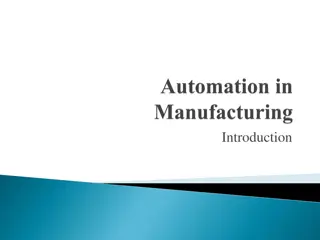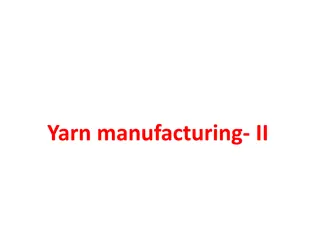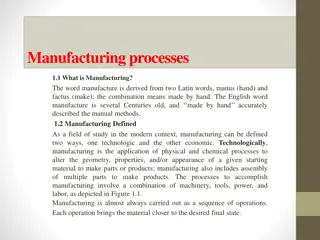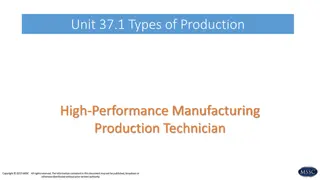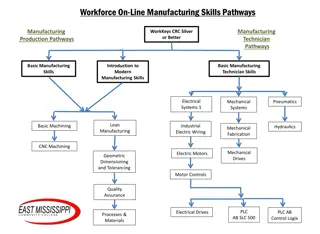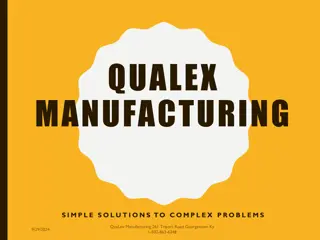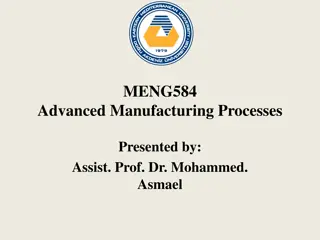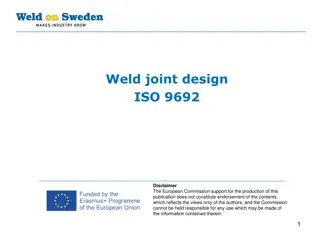Understanding Joint Products and By-Products in Manufacturing Processes
Joint products and by-products are key concepts in manufacturing processes, where joint products are of almost equal value and importance, while by-products have relatively small value but emerge incidentally. Co-products are produced simultaneously but not from the same raw material. This article explains the features, examples, and distinctions between these product types.
Download Presentation

Please find below an Image/Link to download the presentation.
The content on the website is provided AS IS for your information and personal use only. It may not be sold, licensed, or shared on other websites without obtaining consent from the author. Download presentation by click this link. If you encounter any issues during the download, it is possible that the publisher has removed the file from their server.
E N D
Presentation Transcript
Joint Products: Joint products represent two or more products of almost equal importance which are produced in natural proportions simultaneously from the same material in the same process. Joint products are usually of equal economic importance or commercial value. No single product can be identified as of more value or as a major product. ICMA London has defined Joint products as two or more products separated in processing, each having a sufficiently high saleable value to merit recognition as a main product. Examples: Dairy Industry-Skimmed milk, butter, cream etc. Oil refining- Gasoline, Petrol, Diesel, Coal, Tar, Kerosene etc.
Features: Joint products are of almost equal importance no single one of them can be regarded as the main product. These are produced simultaneously from the same material and common production process. Usually joint products require further processing after the point of separation.
By Products: By products are the secondary products in terms of sales value arising in the course of manufacturing the main product. By products are products of relatively small value which emerge incidentally in the course of manufacturing the main product. Features: By products are of relatively small value. They emerge incidentally in the course of manufacturing the main product. Example: Oil refinery-Petrol and diesel are main products, coal, tar and wax are the by-products. Dairy Industry -butter and skimmed milk are the main products but butter milk is the by product. Sugar Industry -Sugar is the main product and Bagasse is the by product.
Co products: Co products, generally, refer to two or more products produced simultaneously, but not necessarily from the same processing operations. Hence, they are the products produced together. However, they are not produced from the same raw material and by same production process. Example: Different Vehicles like mopeds, motor cycles, scooters and auto-rickshaw produced by Bajaj Auto.
Joint Product V/S By Product Value: Joint products are of almost equal value. Whereas by products are of relatively small value. Production: Joint products are produced simultaneously unlike the by products which are incidentally produced in addition to the main product. Normally there exists a direct quantitative relationship among joint products. It need not be there in case of main product and by product. Joint products and By-products have different accounting treatment. Normally Joint products require further processing after the pint of separation. By products is generally sold in the condition in which it emerges.
Accounting for Joint products There are two types of costs relating to joint products. Joint Costs Separate Costs. When there are joint products emerging from a particular process the products are not identified as different individual products until a certain stage of production. This point is called split off point or point of separation. All the costs incurred up to the split off point when the products get separated are called joint costs. All the costs which are incurred after the split off point are called subsequent cost or separate costs.
While accounting for joint products the joint costs actually pose the main problem. This is so because joint costs cannot be traced to individual products and the cost accountant is faced with problem of apportioning the joint cost incurred to various joint products produced. On the contrary subsequent costs pose no problem because such costs relate to individual products. These are therefore charged to the appropriate products. Accounting for Joint products means the apportionment of joint costs to each of the joint products. To ascertain the total cost of each joint product it is necessary to apportion and assign the joint cost to different joint products. Cost determination is necessary for price fixation, stock valuation and computation of profit on sale of different joint products.
Methods of apportioning Joint costs: Physical units Method / Physical measurement method: Under this method the common costs of joint products are allocated on the basis of physical output of each joint product at the split-off point. This method is suitable where the physical units of joint products are same. Adoption of this method may be difficult when the output of different joint products is not measurable in the same units. Market Value Method: This is the most popular and convenient method of apportionment of the joint costs. The joint costs are allocated on the basis of relative sales value of each joint product. Joint costs are distributed to joint products on the basis of their ability to earn revenue. The assumption is that the product with higher sales value has to bear larger portion of the joint costs, than the product with lower sales value. Market value may mean any of the following:
Market Value of Separation Point: Under this method the market value of the joint products at the split off point is ascertained and the joint costs are apportioned in that ratio. This method is suitable where further processing costs after separation point are incurred disproportionately or where all the joint products are not subject to further processing. Market value after further processing method: Under this method joint costs are apportioned in the ratio of market value of the joint products after further processing. Thus, the sales value at the finished stage are taken as the basis for apportionment. It is easy to ascertain the market value of the products at the final stage; compared to that at the separation point.


